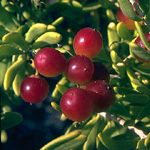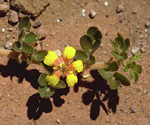 |
This small family is distributed throughout the drier tropics and subtropics
of the world, usually in semi-arid climates. In Australia, members of
the family are common and sometimes dominant in arid and semi-arid areas
throughout the continent, especially on calcareous or saline soils.
Characteristic features of the family Zygophyllaceae in Australia include:
- shrubs or herbs, often with jointed, somewhat succulent branches,
sometimes prostrate or mat-forming (Tribulus)
- leaves alternate or opposite, simple, pinnate or with 2 leaflets (Zygophyllum),
usually rather fleshy, sometimes with prominent, green and leafy stipules
- flowers solitary, white or yellow, regular, with 4 or 5 free sepals
and petals and usually 8 or 10 stamens
- ovary superior with 4 or 5 fused carpels, developing into a winged
fruit, or some with hard, radiating spines, or rarely (Nitraria)
a fleshy berry
Description
Evergreen shrubs, or woody scrambling vines, or annual, biennial or perennial
terrestrial herbs. Perennating by taproots. Stem internodes solid, terete
or angled. Internal secretions not obvious. Plants glabrous, or with simple,
non-glandular, unicellular hairs. Leaves alternate and spiral, or opposite,
cauline if herbs, petiolate or rarely sessile. Stipules present, distinct
and free from the petiole, or interpetiolar, green and leafy, persistent;
stipellae present. Lamina once compound, bifoliolate or paripinnate, rarely
simple or unifoliolate, symmetric or conspicuously asymmetric; leaflets
filiform, acicular, subulate, linear, lanceolate, ovate, elliptic, oblanceolate,
obovate or oblong; base cuneate, attenuate, lobed, oblique or rarely auriculate;
margins entire, ±flat; one-veined, or the venation parallel, or
pinnate, or not obvious, with the midrib prominent or inconspicuous, and
the tertiary venation not reticulate; surfaces not punctate; herbaceous
or succulent. Flowers all bisexual. Inflorescences axillary, consisting
of solitary flowers. Bracts and bracteoles absent. Pollination by insects.
Flowers odourless or fragrant, stalked. Floral disc present; nectaries
present on the disc. Perianth regular, of 2 dissimilar whorls, imbricate
in bud. Calyx segments free, of 4–5 sepals, herbaceous. Corolla segments
free, of (3–) 4–5 petals, alternating with the sepals, white, cream, yellow
or orange, without contrasting markings, membranous; claws present or
absent; lobes ±entire or notched, emarginate, bifid or bilobed.
Fertile stamens (4–6) 8 or 10, both alternating with and opposite to,
or rarely only opposite to the sepals, free of the corolla, free of the
ovary and style, distinct from each other, all ±equal or alternating
long and short. Anthers dorsifixed, versatile, opening sideways or inwards
by longitudinal slits, 2-celled. Ovary superior and sessile. Carpels (3–)
4–5, fused; ovary with (3–) 4–5 locules. Style terminal, single and unbranched,
or single and branched above, truncate. Ovules 1–7 per locule, stalked;
placentation axile. Fruit dry or fleshy, dehiscent, schizocarpic, or indehiscent;
a loculicidal capsule, or a drupe, or a schizocarp forming 1-winged samaras
(samarium); the perianth on the maturing fruit deciduous, or dry and persistent.
Disseminule macro-surface winged or with spines; micro-surface ±smooth,
muricate or tuberculate, cream, yellow, brown or black, glossy or dull.
Seeds 2 per fruit. Aril absent. Cotyledons 2. Embryo straight or curved.
(Note: this description has been generated from the coded data compiled
for the key. Any errors in the key data will be reflected in the descriptions.)
|

Nitraria billardierei (fruits)
Photo: A.S.George © A.S.George

Nitraria billardierei (habit)
Photo: M.Fagg © M.Fagg

Tribulopis bicolor (flower)
Photo: M.Fagg © M.Fagg

Tribulus astrocarpus (fruits)
Photo: D.Jones © D.Jones

|